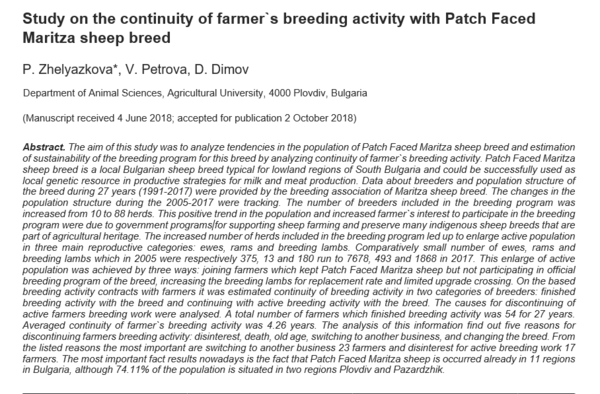Study on the continuity of farmer`s breeding activity with Patch Faced Maritza sheep breed

Abstract. The aim of this study was to analyze tendencies in the population of Patch Faced Maritza sheep breed and estimation of sustainability of the breeding program for this breed by analyzing continuity of farmer`s breeding activity. Patch Faced Maritza sheep breed is a local Bulgarian sheep breed typical for lowland regions of South Bulgaria and could be successfully used as local genetic resource in productive strategies for milk and meat production. Data about breeders and population structure of the breed during 27 years (1991-2017) were provided by the breeding association of Maritza sheep breed. The changes in the population structure during the 2005-2017 were tracking. The number of breeders included in the breeding program was increased from 10 to 88 herds. This positive trend in the population and increased farmer`s interest to participate in the breeding program were due to government programs for supporting sheep farming and preserve many indigenous sheep breeds that are part of agricultural heritage. The increased number of herds included in the breeding program led up to enlarge active population in three main reproductive categories: ewes, rams and breeding lambs. Comparatively small number of ewes, rams and breeding lambs which in 2005 were respectively 375, 13 and 180 run to 7678, 493 and 1868 in 2017. This enlarge of active population was achieved by three ways: joining farmers which kept Patch Faced Maritza sheep but not participating in official breeding program of the breed, increasing the breeding lambs for replacement rate and limited upgrade crossing. On the based breeding activity contracts with farmers it was estimated continuity of breeding activity in two categories of breeders: finished breeding activity with the breed and continuing with active breeding activity with the breed. The causes for discontinuing of active farmers breeding work were analysed. A total number of farmers which finished breeding activity was 54 for 27 years. Averaged continuity of farmer`s breeding activity was 4.26 years. The analysis of this information find out five reasons for discontinuing farmers breeding activity: disinterest, death, old age, switching to another business, and changing the breed. From the listed reasons the most important are switching to another business 23 farmers and disinterest for active breeding work 17 farmers. The most important fact results nowadays is the fact that Patch Faced Maritza sheep is occurred already in 11 regions in Bulgaria, although 74.11% of the population is situated in two regions Plovdiv and Pazardzhik.




